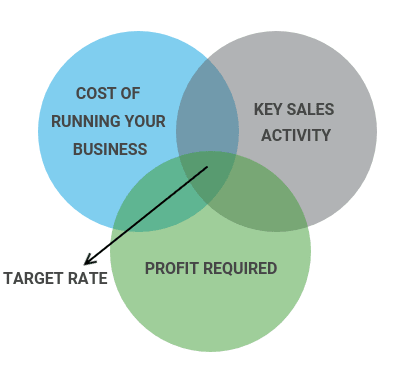Do you have a comprehensive pricing strategy or are you flying in the dark when it comes to quoting jobs for your building and trade services business?
Not knowing what you should be charging could result in you working long hours in your business for little financial reward.
Knowing how to create a pricing structure for your business will save you hours of tireless quoting.
The first principle to get right is knowing your target rate. That is, what dollar number do you need to recover per hour or per product, for your business to meet its operating overheads and return a profit to the owners.
One of the key success factors of a profitable building and trades services business is understanding what their target rate is and consistently measuring their results against it.
SO, HOW DO YOU DETERMINE A TARGET RATE?
 Target rate is a calculation based on the costs of running the business, the key sales activity and the profit required.
Target rate is a calculation based on the costs of running the business, the key sales activity and the profit required.
Firstly, identify the costs of running your business, both variable and fixed costs.
Fixed costs could include a monthly rent payment on a storage shed, or your annual business vehicle registration, while variable costs refer to supplies required to deliver the job. For a painter and decorator this could be the volume of paint or brushes determined by the size of the contract. Staffing costs could be either fixed or variable depending on the type of staff contract.
Taking these factors into account will determine the minimum amount of sales required to cover costs or what is referred to as the break-even point for the business.
Next, determine the key sales activity that drives the business. For a bricklayer, the key sales activity might be number of bricks laid. For an electrician, it might be billable hours.
Finally, determine what a reasonable profit margin would be for all your efforts as the owner of the business. This will vary from business to business.
Let’s look at an example.
Paul and Anna own a plumbing business. After analysing their business, they determine that its running costs are $500,000 and they desire a profit of $200,000 to support their family. This means that the business needs to generate $700,000 in sales to fulfill its needs. They have 4 employees and determine that for the year they should bill a total of 6,400 hours to customers. The target rate can therefore be worked out by dividing $700,000 by 6400 hours to arrive at a figure of $109.37.
Business Costs | $500,000 |
Owner Profit | $200,000 |
Desired Sales Amount | $700,000 |
Available Billable Hours | 6400 |
Target Rate = $700,000/6400 | $109.37 |
Once you know your target rate, the next step is to analyse it.
Is the rate competitive? Is it achievable?
This is just the start of the process and moving forward your target rate should then be used as a benchmark for future planning.
By using “what if” scenarios the business can look at the impact reducing costs or increasing employee efficiency can have on either target rate or business profitability.
Knowing, measuring, and focusing on the numbers that drive your business will help you to increase your profit and improve efficiency.
For more information
For more information on how to determine the target rate for your business contact your local RSM adviser who can guide you through the process.


